Dry, thick, and raised patches on the skin are the most common sign of psoriasis. These patches are often covered with a silvery-white coating called scale, and they tend to itch.
While patches of thickened, dry skin are common, psoriasis can cause many signs and symptoms. What you see and feel tends to vary with the:
Type of psoriasis you have
Places psoriasis appears on your body
Amount of psoriasis you have
Types of psoriasis
The following pictures show what each type psoriasis can look like on the skin. You’ll also see how psoriasis can affect your nails and joints.
Plaque (plack) psoriasis
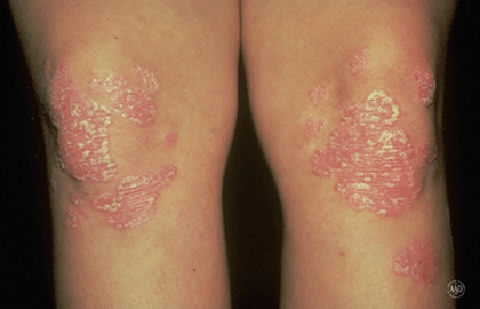
Patches of thick, raised skin called plaques
Scale (a dry, thin, and silvery-white coating) covers some plaques
Plaques of different sizes
Smaller plaques joining together to form larger plaques
Plaques usually form on the scalp, elbows, knees, or lower back, but they can develop anywhere on the skin. It’s common for plaques to itch, but try not to scratch. Scratching can cause the patches to thicken. To stop the itch, dermatologists recommend treating the psoriasis.
Guttate (gut-tate) psoriasis
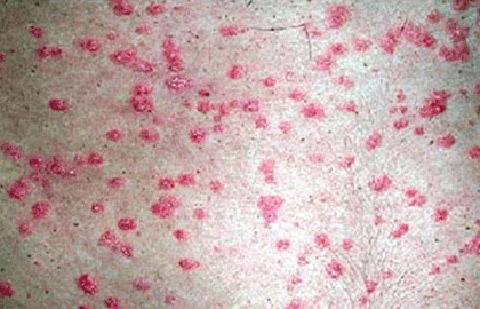
When someone gets this type of psoriasis, you often see tiny bumps appear on the skin quite suddenly. The bumps tend to cover much of the torso, legs, and arms. Sometimes, the bumps also develop on the face, scalp, and ears. No matter where they appear, the bumps tend to be:
Small and scaly
Salmon-coloured to pink
Temporary, clearing in a few weeks or months without treatment
When guttate psoriasis clears, it may never return. Why this happens is still a bit of a mystery. Guttate psoriasis tends to develop in children and young adults who’ve had an infection, such as strep throat. It’s possible that when the infection clears so does guttate psoriasis.
It’s also possible to have:
Guttate psoriasis for life
See the guttate psoriasis clear and plaque psoriasis develop later in life
Plaque psoriasis when you develop guttate psoriasis
There’s no way to predict what will happen after the first flare-up of guttate psoriasis clears.
Inverse psoriasis
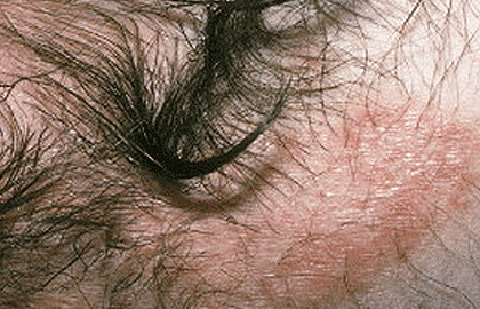
This type of psoriasis develops in areas where skin touches skin, such as the armpits, genitals, and crease of the buttocks. Where the inverse psoriasis appears, you’re likely to notice:
Smooth, red patches of skin that look raw
Little, if any, silvery-white coating
Sore or painful skin
Other names for this type of psoriasis are intertriginous psoriasis or flexural psoriasis.
Pustular psoriasis
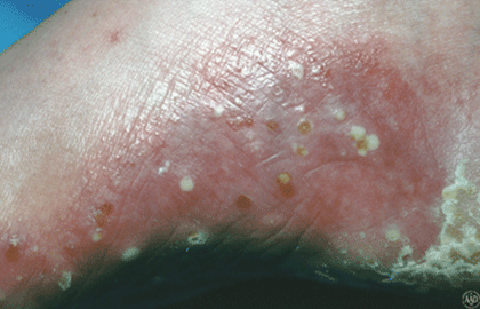
This type of psoriasis causes pus-filled bumps that usually appear only on the feet and hands. While the pus-filled bumps may look like an infection, the skin is not infected. The bumps don’t contain bacteria or anything else that could cause an infection. Where pustular psoriasis appears, you tend to notice:
Red, swollen skin that is dotted with pus-filled bumps
Extremely sore or painful skin
Brown dots (and sometimes scale) appear as the pus-filled bumps dry
Pustular psoriasis can make just about any activity that requires your hands or feet, such as typing or walking, unbearably painful.
Pustular psoriasis (generalized)
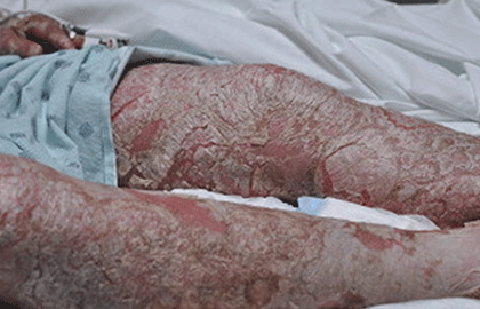
Serious and life-threatening, this rare type of psoriasis causes pus-filled bumps to develop on much of the skin. Also called von Zumbusch psoriasis, a flare-up causes this sequence of events:
Skin on most of the body suddenly turns dry, red, and tender.
Within hours, pus-filled bumps cover most of the skin.
Often within a day, the pus-filled bumps break open and pools of pus leak onto the skin.
As the pus dries (usually within 24 to 48 hours), the skin dries out and peels (as shown in this picture).
When the dried skin peels off, you see a smooth, glazed surface.
In a few days or weeks, you may see a new crop of pus-filled bumps covering most of the skin, as the cycle repeats itself.
Anyone with pustular psoriasis also feels very sick, and may develop a fever, headache, muscle weakness, and other symptoms. Medical care is often necessary to save the person’s life.
Erythrodermic psoriasis
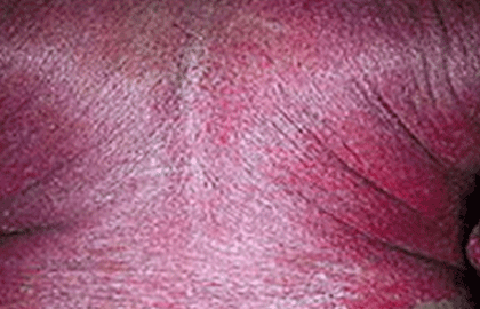
Serious and life-threatening, this type of psoriasis requires immediate medical care. When someone develops erythrodermic psoriasis, you may notice:
Skin on most of the body looks burnt
Chills, fever, and the person looks extremely ill
Muscle weakness, a rapid pulse, and severe itch
Most people who develop erythrodermic psoriasis already have another type of psoriasis. Before developing erythrodermic psoriasis, they often notice that their psoriasis is worsening or not improving with treatment. If you notice either of these happening, see a board-certified dermatologist. People who develop erythrodermic psoriasis should seek immediate medical attention. Among other dangers, the person may be unable to keep warm, so hypothermia can set in quickly.
Nail psoriasis
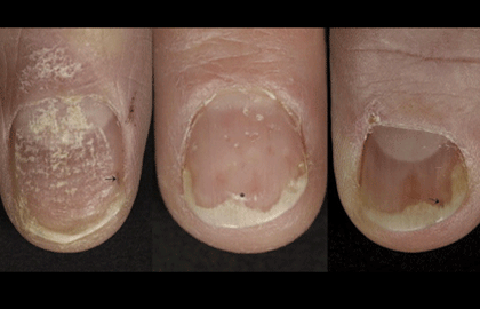
While many people think of psoriasis as a skin disease, you can see signs of it elsewhere on the body. Many people who have psoriasis see signs of the disease on their nails. With any type of psoriasis, you may see changes to your fingernails or toenails. About half of the people who have plaque psoriasis see signs of psoriasis on their fingernails at some point.
When psoriasis affects the nails, you may notice:
Tiny dents in your nails (called “nail pits”)
White, yellow, or brown discoloration under one or more nails
Crumbling, rough nails
A nail lifting up so that it’s no longer attached
Build-up of skin cells beneath one or more nails, which lifts up the nail
Treatment and proper nail care can help you control nail psoriasis.
Psoriatic arthritis
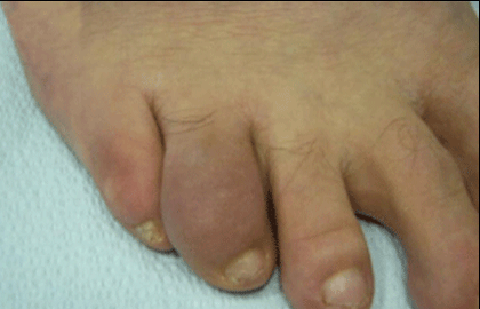
When psoriasis affects the joints, it causes a disease known as psoriatic arthritis. If you have psoriasis, it’s important to pay attention to your joints. Some people who have psoriasis develop a type of arthritis called psoriatic arthritis. This is more likely to occur if you have severe psoriasis. Most people notice psoriasis on their skin years before they develop psoriatic arthritis. It’s also possible to get psoriatic arthritis before psoriasis, but this is less common.
When psoriatic arthritis develops, the signs can be subtle. At first, you may notice:
A swollen and tender joint, especially in a finger or toe
Heel pain
Swelling on the back of your leg, just above your heel
Stiffness in the morning that fades during the day
Like psoriasis, psoriatic arthritis cannot be cured. Treatment can prevent psoriatic arthritis from worsening, which is important. Allowed to progress, psoriatic arthritis can become disabling.
https://www.aad.org/public/diseases/psoriasis/what/symptoms
No comments:
Post a Comment